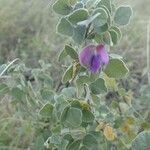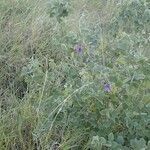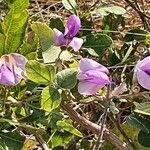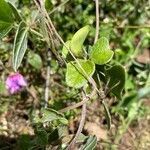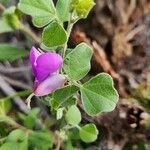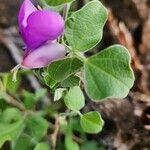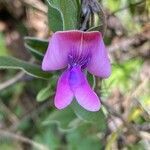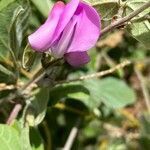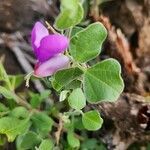Leaves pinnately 3-foliolate; leaflets 1.2–4.6 × 0.9–4 cm, ovate, subacute to emarginate and mucronulate at the apex, rounded at the base, moderately to densely appressed pubescent, appearing silvery beneath, 3-veined from the base; terminal leaflet sometimes broadly lobed, lateral leaflets often bilobed; petiole 0.7–5.8 cm long; rhachis 2–30 mm long; petiolules 1–2 mm long; stipules 3–5 mm long, ovate to lanceolate, striate; stipels minute.
Flowers axillary, solitary, in pairs or in 3–5-flowered fascicles, sometimes appearing falsely as a terminal inflorescence when leaves on slender side branches are not developed; pedicels 4–8 mm long; bracts 3 mm long, ovate-lanceolate, striate; bracteoles 1–3 mm long, linear to elliptic.
Standard purplish-red, flushed red-brown or green outside, mostly lilac at the base inside and flushed crimson at the apex, 14–17 × 15–18 mm, oblate; wings pink to reddish or bluish-purple; keel sometimes slightly twisted at the apex, mostly white with a purple tip.
Ovary 6–9 mm long, linear-oblong, compressed, minutely puberulent; style 5–7 mm long, stigma minute, terminal, capitate, not penicillate.
Stems annual, slender, becoming woody, rather angular; sparsely pubescent to velvety with silvery to ferruginous hairs.
Erect or scrambling herb or shrub, 30–240 cm tall, arising from a perennial woody tuberous rootstock.
Calyx appressed silky pubescent; tube 4–6 mm long; lobes 2–5 mm long, upper pair completely fused.
No fruiting material seen from the Flora Zambesiaca area; pod and seed descriptions from F.T.E.A.
Pods 5–5.8 × 0.8–1.1 cm, linear-oblong, falcate, densely pubescent, 5–7-seeded.
Seeds 6.5–7.5 × 5–5.5 × 2–2.5 mm.
